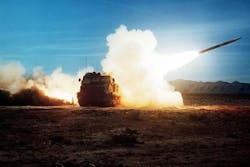Army asks Marvin Land Systems to upgrade and redesign auxiliary power units (APUs) on MLRS vehicles
Officials of the Army Contracting Command in Warren, Mich., issued a presolicitation on Tuesday (W56HZV-16-R-L171) asking the Marvin Group's Marvin Land Systems segment in Inglewood, Calif., for additional development of hydraulic and electric APU for the Army's MLRS vehicle.
Marvin Land Systems provides the APU and environmental control unit for the MLRS vehicles deployed today. The M270 MLRS is an armored self-propelled rocket launcher able to fire salvos of guided and unguided rockets at targets nearly 200 miles away. It has been in service since 1983.
Army researchers are asking Marvin Land Systems to develop the MLRS APU further, as well as demonstrate an electric-only output APU that would fit on armored ground vehicles about the size of the M2 Bradley Fighting Vehicle. The upcoming contract to Marvin Land Systems has yet to be negotiated.
A vehicle's auxiliary power unit provides energy for functions other than propulsion. It provides electrical power to the MLRS vehicle -- especially to enable its companion environmental control unit to provide cooling for MLRS crews who are operating in severe desert conditions.
The APU weighs less than 330 pounds, and provides 8.5 kilowatts of power at 28 volts DC output, with voltage ripple independent of the engine speed or load at less than 100 millivolts of root mean square (RMS) power.
The military has nearly an insatiable appetite for increasing amounts of electrical power to run a wide variety of computers, video displays, communications equipment, tactical networking, battery chargers, signals intelligence (SIGINT) systems and electronic warfare (EW) gear.
story continues below
Power demands today are far and away more than vehicle designers could conceive of back in 1983 when the MLRS first was fielded. Marvin Land Systems engineers most likely will investigate new ways for the MLRS APU to provide additional amounts of power, as well as shrink its size and weight and ability to provide power for a wide variety of land vehicles.
On the upcoming contract Marvin Land Systems will do the work at company facilities in Inglewood, Calif. For more information contact Marvin Land Systems online at www.marvingroup.com/index.php/companies/mls, or the Army Contracting Command-Warren at http://acc.army.mil/contractingcenters/acc-wrn.
Learn more: search the Aerospace & Defense Buyer's Guide for companies, new products, press releases, and videos
